Serene Seaside Retreat Is Built With Wood Scraps
Wood waste is beautiful in this 'house of offcuts,' which features 12,000 pieces of oak flooring leftovers.

Johan Dehlin
The notion of using recycled materials to create new things is slowly but surely catching on, with a growing number of companies selling fashion, jewelry, and even bikes made from recycled content. Architects are getting the message too, and creating beautiful buildings that feature recycled items, like this modern live-work residence made with upcycled tiles or this community cafe made with recycled bottles and cartons.
Of course, designing with recycled materials in mind can entail adapting or even revamping the whole design process to accommodate extra steps like cleaning, sorting, and resizing recycled items. But it can be worth it, as Swedish firm Kolman Boye Architects shows with their elegant renovation of a weekend retreat in Lillesand, Norway, which uses offcut wood that would have otherwise been discarded.
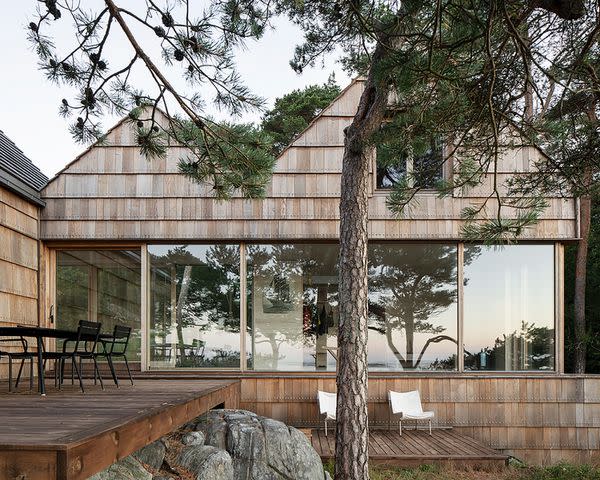
Johan Dehlin
Dubbed the Saltviga House, the project features 12,000 pieces of oak wood flooring materials that cover the exterior walls and roof. The offcuts were sourced from Danish flooring company Dinesen, which had a large number of extra pieces on hand. As the firm explains, they were already familiar with the company, thus easily giving birth to the idea to "ennoble" these leftover materials:
"In our recent projects and in our teaching and research, we have come across Dinesen materials as both the traditional floors and as a scrap, a leftover, an offcut from the production of made-to-measure floors. Making and thinking with these leftovers from the production gave rise to a notion of making a building of them as a sympathetic way of using and ennobling scrap materials that would otherwise have been used as firewood. Besides being beautiful, the off-cuts are low in embodied carbon, and could offer an alternative to more commonly used and more carbon intensive materials."
The house is situated on a rocky site on the sea's edge, where the clients, a family with young children, already had a holiday cabin which was in a rundown state.
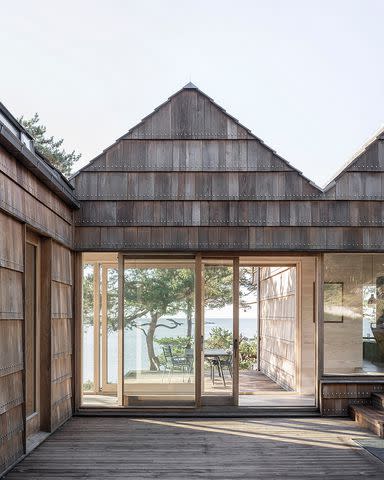
Johan Dehlin
The initial goal was to repair and renovate it; however, this proved to be impossible as the original structure was too dilapidated.
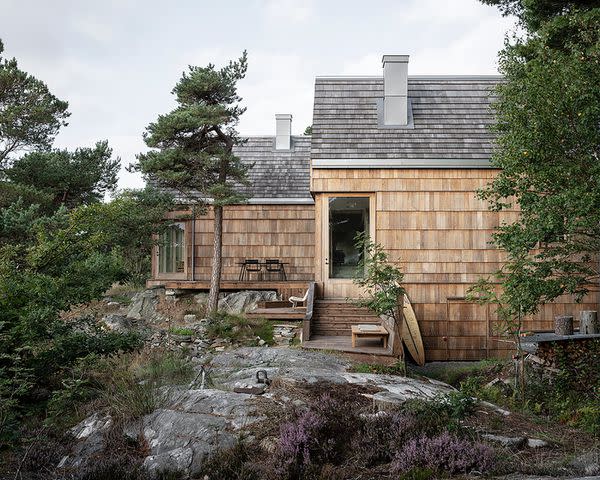
Johan Dehlin
In its place, the architects have realized a new design that works with the site's variable elevations. The new project spans only one floor, but seems to cascade over five different levels, in order to minimize potential impacts to the landscape.
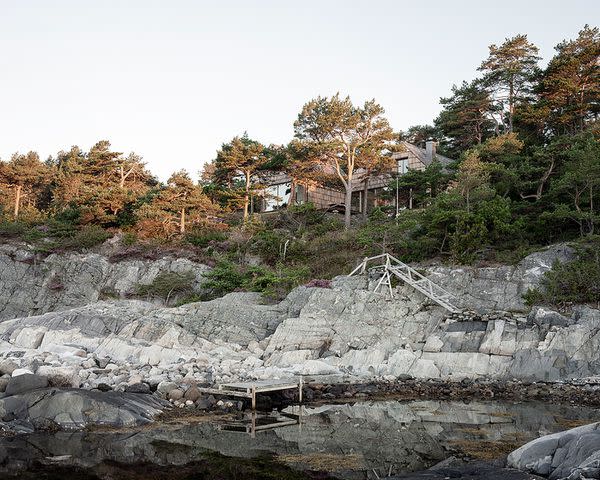
Johan Dehlin
In order to find an efficient way of working with this large number of offcuts—which came in a variety of sizes and types—the architects developed a strategy of sorting that classified the pieces according to size, quantity, and quality. They even built some full-scale mock-ups to test different stacking and layering combinations. They say:
"Differing from traditional split wooden shingles used in Norway, the research into these sawn timber planks resulted in a straightforward yet complex approach that required traditional material knowledge as well as a considerable process development to make it work in a timely and economical fashion."
In order to further minimize waste, the firm worked in conjunction with its suppliers, carpenters, and joiners to process and prefabricate the components as much as possible. This included pre-cutting pieces to size, then pre-drilling, and pre-treating them prior to transporting them to the work site.
In all, the project consists of three volumes, one of which functions as an openable "wind-barrier" and as a connective element between another two main volumes—one for living, another for sleeping and bathing.
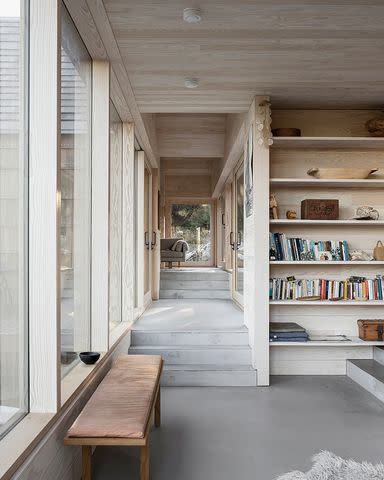
Johan Dehlin
The volumes are configured to form two sides, one of which is characterized by a deck that is open to the sea, while the other side is a courtyard that opens towards the forest.
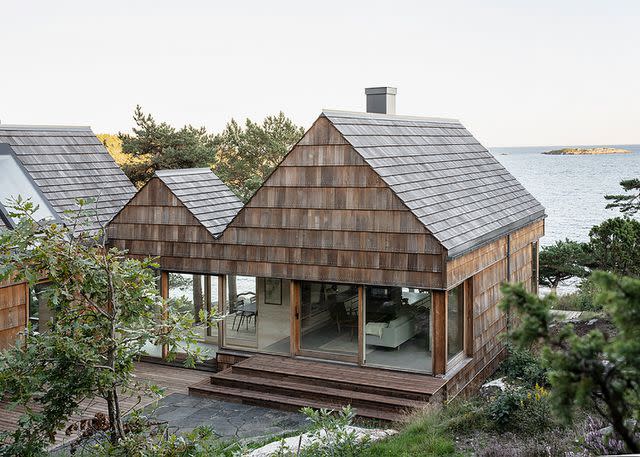
Johan Dehlin
Inside the home, the spaces are distinguished by different ceiling heights or changes in the floor level. The connective volume is emphasized by a long stretch of windows that look out to sea, thus creating a sense of seamlessness between the different parts of the home.
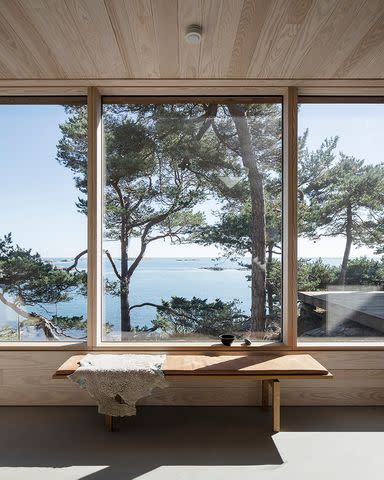
Johan Dehlin
Extra warmth is lent to the interior by the Douglas fir cladding that lines the walls, as they do here in the stairs leading up to the bedroom.

Johan Dehlin
Douglas fir offcuts were also used for the kitchen cabinets.
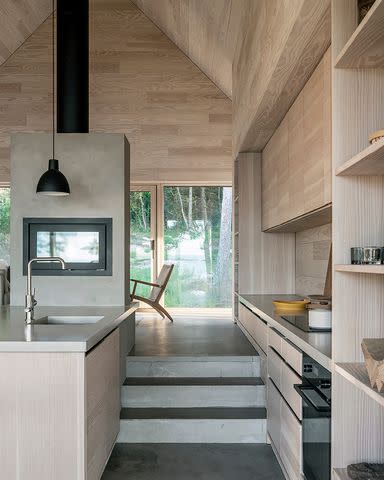
Johan Dehlin
Here is a view from the kitchen, looking into the dining area, and out to the sea. The open plan configuration helps to maximize the sense of space and light.

Johan Dehlin
Ultimately, the architects say that this approach is about using resources frugally and in a beautiful way. The ideas of recycling, reusing, reducing, upcycling, and repurposing things may mean having to rethink the way we usually do things, but it can also mean ending up with something that is much more beautiful and meaningful.

